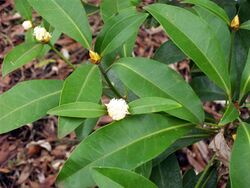Biology:Baloghia
From HandWiki
Short description: Genus of flowering plants
| Baloghia | |
|---|---|

| |
| Baloghia marmorata | |
| Scientific classification | |
| Kingdom: | Plantae |
| Clade: | Tracheophytes |
| Clade: | Angiosperms |
| Clade: | Eudicots |
| Clade: | Rosids |
| Order: | Malpighiales |
| Family: | Euphorbiaceae |
| Subfamily: | Crotonoideae |
| Tribe: | Codiaeae |
| Genus: | Baloghia Endl.[1] |
| Type species | |
| Baloghia lucida[2] Endl.
| |
| Synonyms[3] | |
|
Steigeria Müll.Arg. | |
Baloghia is a genus of plants under the family Euphorbiaceae first described as a genus in 1833.[2][4] It is native to Australia (Queensland, New South Wales, Lord Howe I., Norfolk Island), New Caledonia, and Vanuatu.[3][5][6] Cocconerion is a close relative.[7]
- Species[3]
- Formerly included
moved to Austrobuxus Fontainea Scagea
- B. carunculata - Austrobuxus carunculatus
- B. oligostemon - Scagea oligostemon
- B. pancheri - Fontainea pancheri
References
- ↑ "Baloghia". Australian Plant Name Index (APNI), IBIS database. Centre for Plant Biodiversity Research, Australian Government, Canberra. http://www.anbg.gov.au/cgi-bin/apni?TAXON_NAME=Baloghia. Retrieved 27 July 2013.
- ↑ 2.0 2.1 Tropicos, Baloghia Endl.
- ↑ 3.0 3.1 3.2 Kew World Checklist of Selected Plant Families
- ↑ Endlicher, Stephan Friedrich Ladislaus. 1833. Prodromus Florae Norfolkicae 84-85 in Latin
- ↑ "Genus Baloghia". PlantNET - New South Wales Flora Online. Royal Botanic Gardens & Domain Trust, Sydney Australia. http://plantnet.rbgsyd.nsw.gov.au/cgi-bin/NSWfl.pl?page=nswfl&lvl=gn&name=Baloghia. Retrieved 27 July 2013.
- ↑ Govaerts, R., Frodin, D.G. & Radcliffe-Smith, A. (2000). World Checklist and Bibliography of Euphorbiaceae (and Pandaceae) 1-4: 1-1622. The Board of Trustees of the Royal Botanic Gardens, Kew.
- ↑ Tokuoka, T. (2007) Molecular Phylogenetic Analysis of Euphorbiaceae Sensu Stricto Based on Plastid and Nuclear DNA Sequences and Ovule and Seed Character Evolution.” Journal of Plant Research 120 (4): 511–22.
Wikidata ☰ Q609500 entry
 |

